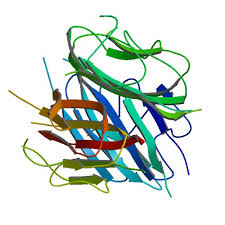An alternative to Adiponectin
August 13, 2014 | Wednesday | Features | By BioSpectrum Bureau
An alternative to Adiponectin
Adiponectin (In its beta structure above) is difficult to manufacture in the laboratory
Adiponectin is a hormone which regulates glucose and fat metabolism. More than 12500 scientific reports have been published on this molecule. A large number of clinical studies have already established that the plasma level of this hormone is diminished in multiple diseases like insulin resistance, obesity, type II diabetes, cardiovascular diseases and even cancers. Yet, replenishing this hormone because Adiponectin is a pretty large peptide. Monomeric (single molecule) adiponectin's molecular weight is about 30kda. On top of that adiponectin oligomerize and complexity regarding adiponectin is heightened by the fact that each oligomer can have distinct functions. Therefore, first producing such a big peptide in the laboratory, followed by its proper oligomerization is logistically impossible, explains Dr Sabayasachi Sanyal, principal scientist, Central Drug Research Institute (CDRI), Lucknow.
The medical world was looking for a small molecule which could mimic the action of this hormone. GTDF is the abbreviation form of (2S,3S)-(+)-3',4',5,7-tetrahydroxydihydroflavonol-6-C-β-D-glucopyranoside, the chemical name of a novel compound that was isolated from the stem bark of the Himalayan Elm (Ulmus wallichiana) by CSIR-CDRI medicinal chemist Dr Rakesh Maurya and team and is now being synthesized in laboratory.
Dr Sanyal and his team has discovered it as an adiponectin-mimicking molecule. Speaking about its discovery, He said, "Mr Chattopdhyay at CSIR-CDRI, where it was found to enhance survival, proliferation, differentiation and mineralization of osteoblast cells that are responsible for forming bone. We had a lucky break, while studying its effect on secondary (steroid-induced) osteoporosis, where its effect was being studied on dexamethasone (a synthetic glucocorticoid)-induced bone loss. In our model a high dose of dexamethasone was used, at this dose dexamethasone not only induces bone loss, it also leads to death of animals after two weeks and amazingly the animals that were co-treated with GTDF were not only alive, they were as healthy as the control rats who did not receive dexamethasone. We therefore not only compared the bones in these animals but also checked for other phenotypic changes and found that among various effects, GTDF completely rescued these animals from dexamethasone-induced insulin-resistance."
Identification of GTDF as a small adiponectin mimetic molecule is of paramount importance and is considered as an important therapeutic tool for the treatment of metabolic diseases caused by adiponectin deficiency.
The findings of the study are published in American journal of associations' journal Diabetes.










